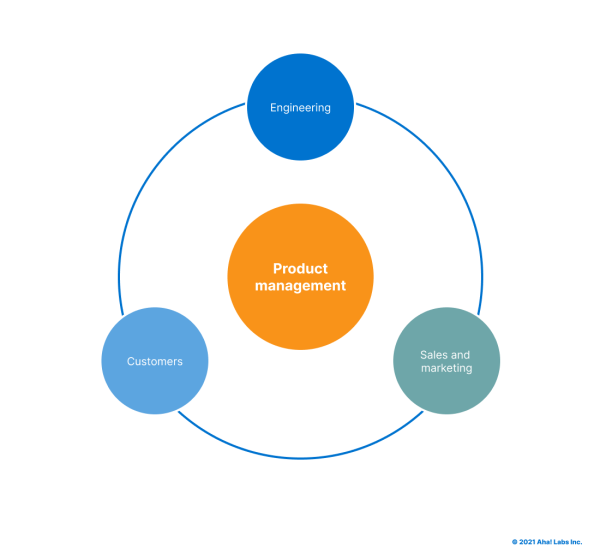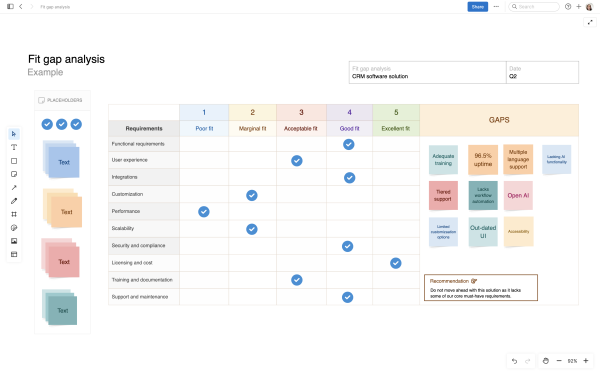How to structure your product development team
Last updated: September 2023
Behind every great product is a great product development team. Product development teams are responsible for understanding customer needs, creating something new, and bringing it to market. Besides choosing what to build, they communicate the benefits and measure the performance of the product — crucial duties within any company. The ultimate goal is to deliver value to customers and support the business.
But many people still think of product development teams quite narrowly — as the group of engineers and designers working together to build the product. While engineering is an important component of the product development lifecycle, it is just one part of a much larger whole.
Build products like you have always wanted to — try Aha! Roadmaps now.
Product development refers to the entire process of transforming an idea into a lovable product. It encompasses everything from capturing raw concepts, prioritizing what to build, iterating, and measuring success.
It makes sense, then, that you need a dedicated team to achieve this important and interconnected work. Each member of the product development team contributes their own subject matter expertise and collaborates with the rest of the organization to create products that delight customers.
Read on to learn more about the different functions that make up a product development team and how to structure your organization for product development success.
Who makes up a product development team?
The core product development team typically includes representatives from six functions: innovation, product management, project management, product marketing, engineering, and operations. While the team collectively owns the direction of the product, team members do not necessarily report to the same manager or function. Of course, the exact makeup and structure of your product development team will vary depending on the type and maturity of the company, your specific offerings, release cadence, and any methodologies you follow.

Less mature companies, for example, might not have dedicated product development teams. Instead, each group in the organization works in a silo — completing the tasks for their specific stage of the product lifecycle. Communication with teammates in other functional areas may be irregular or inconsistent. The problem with this approach is that teams can have divergent goals or sets of priorities. This makes it difficult to align everyone working on the product around what customers need and how you will work together to deliver it.
Collaboration is key. Building a product that delights users at every touchpoint of the customer journey requires clear ownership and a solid understanding of what each role on the product development team entails. No matter the products or offerings you are responsible for, delivering a Complete Product Experience (CPE) is what matters in the end. By integrating diverse perspectives and gaining a holistic understanding of every customer touchpoint, you can make better decisions about the product and deliver an exceptional user experience.
Read more: How to structure your product team meeting — with helpful templates
Here is an overview of the functions that make up the core product development team, along with their main responsibilities and common titles for these roles:
Function | Responsibilities | Roles |
Innovation |
|
|
Product management and user experience (UX) |
|
|
Project management |
|
|
Product marketing |
|
|
Engineering |
|
|
Operations |
|
|
Related:
What are the most common product development team structures?
There is no one-size-fits-all structure when it comes to product development. You can organize your product development team around the different products or product lines in your organization, the functional area each team supports (whether that is a product feature or a customer segment), or a specific business or customer need.
Consider these questions as you think about the best organizational structure for your team:
Who are your target customers? How do their needs vary?
Which business goals are you trying to achieve?
Are there multiple products or product lines to be managed?
What resources will be dedicated to each team?
Here is a quick rundown of a few common ways that organizations structure their product teams. Since a product leader typically leads the cross-functional product team, they are involved in every stage of the product development lifecycle. They are well-suited to work closely with their product development teammates to evaluate ideas, define release plans and timing, and clarify exactly what should be built.
Team structure | Description |
By product or product line | A product leader oversees each product or product line. While they only focus on one product, they manage a broad range of initiatives for that product — conducting market research, maintaining the product roadmap, incorporating customer feedback, and partnering with the development team to build new features and functionality. This type of structure is well-suited to large organizations with multiple offerings. |
By product feature | A product leader owns a discrete focus area and communicates with other product managers in the organization about cross-dependencies that exist for the suite of products. The chief product officer typically ensures visibility and cohesion across the broader product organization. This structure is particularly useful for organizations with complex offerings. |
By cross-functional collaboration | Sometimes called product squads, cross-functional groups are especially popular among agile development teams. These groups are often comprised of a product owner or product manager, a coach or scrum master, developers, and sometimes quality assurance (QA) folks. This approach works well in large organizations with sufficient product and development team members and resources to justify creating many smaller teams. |
By customer segment | Product managers are responsible for a different group of customers, each with different needs and expectations. For example, one product manager might focus on enterprise customers while another works exclusively with small and midsize businesses. Organizing by customer segment often makes sense for companies with products that are serving the needs of vastly different markets or industries. |
By customer journey stage | Product managers focus on enhancing the value of a product during a particular stage of the customer journey — including a customer's first experience with a product, onboarding, adoption, and continued use. This approach works well in organizations with a robust product offering and the resources to tackle each customer journey phase in depth. |
By performance metrics | Each product leader owns a set of specific product goals or key performance indicators (KPIs) and works across product features to achieve better results. Organizing your product team by performance metrics can work well if you have a mature product with established KPIs that reflect value created for customers and the business alike. |
Your organization's chosen development methodology can also impact how your product team is organized. Scrum, extreme programming (XP), Scaled Agile Framework® (SAFe®) — each of these brings its own team structure. For example, scrum prescribes a team structure comprised of a product owner, scrum master, and development team. SAFe, on the other hand, is designed for large organizations. Its team structures are similarly complex. Roles are organized into three levels — team, program, and portfolio. Within these levels, roles include software developer, enterprise architect, solution manager, product manager, business owner, and more.
Regardless of which methodology you follow, you will want to organize your team in a way that sets them up for success. Aim for efficient use of resources and effective collaboration.
It is also important to acknowledge the other groups in the organization that also enable product success — such as members of finance, legal, IT, corporate marketing, sales, or support. While the product development team does the primary work of building and delivering a product, these other folks do the complementary work of selling and supporting it.
The best product teams work closely with the rest of the organization, looping them in early and often to support a Complete Product Experience (CPE). This might mean that product leaders have regular check-in meetings with members of the support team to hear the latest customer feedback. Or that project managers collaborate with the finance and legal teams early in the project planning process to identify any bottlenecks or potential issues that might slow the team's progress.
Related:
Connecting the product development team to your strategy
All product development teams need well-defined roles and a sound structure. But it all starts with a clear vision and strategy that describes what you are trying to achieve. This is how you know where you are headed, why, and how you will get there — no matter how your team happens to be structured. You also need purpose-built tools, integrated workflows, and a culture of transparency and collaboration. Everyone in the organization must be committed to delivering value to customers and the business.
Successful teams use purpose-built product development software to align around a shared sense of purpose. With the Aha! software suite, you have everything you need to bring your product strategy to life.
Complete work and collaborate on plans — try Aha! free for 30 days.


